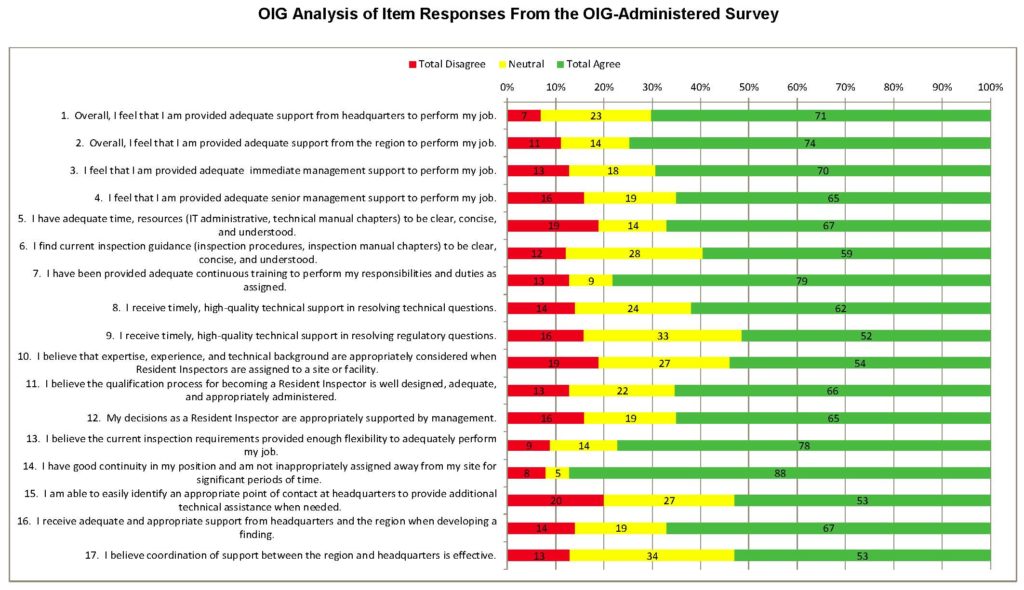Nuclear Energy Activist Toolkit #31
There are at least two NRC inspectors assigned full-time to every nuclear power plant operating today in the United States. Called resident inspectors, these individuals are essentially the agency’s first-line of defenders of nuclear power plant safety.
The use of resident inspectors is not new. The Atomic Energy Commission, NRC’s predecessor, actually began assigning inspectors to nuclear plant sites back in June 1974, nearly four decades ago. That pilot program continued through October 1976 and informed the Commissioner’s decision in 1977 to formally adopt resident inspectors as part of the agency’s oversight program. Twenty inspectors were assigned to nuclear plants in 1978. The March 1979 accident at Three Mile Island accelerated the expansion of the resident inspector program—by 1981, the NRC had resident inspectors at every operating nuclear plant site.
The resident inspectors conduct much of the NRC’s inspection effort. They are complemented by inspectors from the regional and headquarters offices.
The NRC’s Office of the Inspector General recently audited the resident inspector program. Quoting from the audit team’s executive summary:
The Office of the Inspector General (OIG) found that the agency generally provides Residents with sufficient support to enable them to adequately perform their roles and responsibilities. However, there is a perception among Residents that support from headquarters and the regions is, at times, inconsistent.
The OIG surveyed NRC’s resident inspectors about various aspects of their job. The most positive survey results:
- 88% felt they have good continuity in their positions and were not inappropriately assigned away from the site for significant periods of time
- 79% felt they were provided adequate continuous training to perform their assigned duties
- 78% felt the current inspection requirements provided them sufficient flexibility to adequately perform the job
The least positive survey results:
- Only 52% felt they received timely, high-quality technical support in resolving regulatory questions
- Only 53% felt that the coordination of support between the regional and headquarters offices was effective
- Only 53% felt that they could easily identify an appropriate point of contact at headquarters for technical assistance when needed
The most negative survey results:
- 20% felt unable to easily identify an appropriate point of contact at headquarters for technical assistance when needed
- 19% felt they did not have adequate time and materials to be clear, concise, and understood
- 19% did not feel that expertise, experience, and technical backgrounds were appropriately considered in assigning resident inspectors to a site
I encountered some of the latter cases during my brief tenure as a reactor technology instructor at the NRC’s Technical Training Center (TTC). I taught boiling water reactor (BWR) technology. One of my students had recently been hired by the NRC after a 30-year career in the nuclear power industry—all of that experience on pressurized water reactors (PWRs). This student could have easily taught the PWR technology course, but this vast PWR experience was not put to best use working on BWRs. Another student hired just out of college by the NRC did very well on the BWR technology series of classroom and control room simulator training—and was promptly assigned as a resident inspector at a PWR. There was a PWR technology course being taught at the TTC in parallel with the BWR technology course and would have far better prepared this student to be a resident inspector at a PWR.
In addition to feeling the need for better technical support, the OIG’s audit team found that resident inspectors could benefit from more administrative support. The resident inspectors are aided by office assistants limited to working 10 hours per week. Resident inspectors commented that office assistants being allowed to work 15 to 20 hours per week would lessen their administrative burden, thus freeing up additional time for safety inspections and evaluations.
Bottom Line
The NRC’s resident inspectors are the agency’s first line of nuclear power safety defense. The good news is that the majority feel they are properly trained for and focused on their duties. The OIG audit did identify areas where better technical and administrative support would enable the resident inspectors to better perform their important tasks.
As Abe Lincoln observed, you can’t please all the people all the time. But the NRC should be able to please more than half its resident inspectors with its technical support all the time.
The UCS Nuclear Energy Activist Toolkit (NEAT) is a series of post intended to help citizens understand nuclear technology and the Nuclear Regulatory Commission’s processes for overseeing nuclear plant safety.

